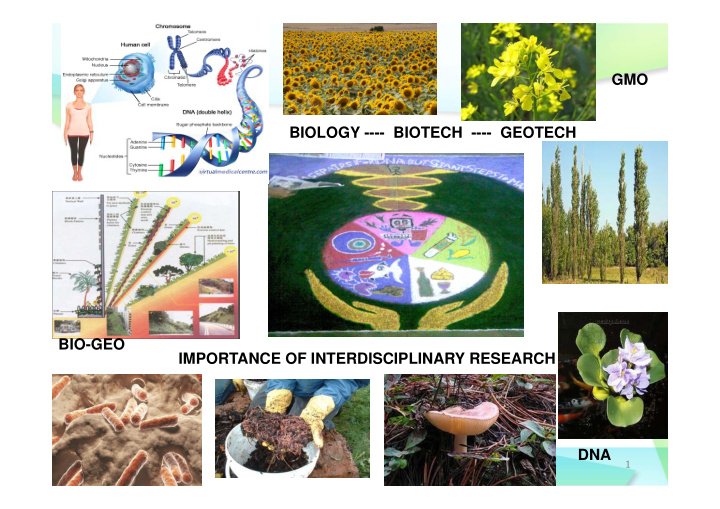



GMO BIOLOGY ---- BIOTECH ---- GEOTECH BIO-GEO IMPORTANCE OF INTERDISCIPLINARY RESEARCH DNA 1
Biogeotechnology Fundamental Applicative 2
For any application such as Bio-fertilizer, Bioremediation…. Sample collection Biological Physico-chemical parameters (Isolation of bacteria) Screening for specific properties Taxonomic identification and phylogenetic analysis Elucidation of microbe interaction Bioprospecting 3
4
Growth of bacteria Water Food/Nutrients Oxygen Temperature pH 5
6
7
8
Serial dilution and viable plate count method 9
10
11
Optimization of growth conditions C, P, N…. Temperature pH 12
Sample collection Biological Physico-chemical parameters (Isolation of bacteria) Screening for specific properties Taxonomic identification and phylogenetic analysis Elucidation of microbe interaction Bioprospecting 13
Screen for specific propertiesc 14
50 43.3 % reduction in cell number on 6h incubation 40 31.7 33.2 with 120 ppm uranium 30 20 3.9 4.2 10 0 Phosphate solubilizing bacterial isolates Figure : Percent reduction in cell number on incubation in 0.1 N NaCl, pH 4 solution amended with 120 ppm uranium for 6 h. Vertical bars represent the mean ± SD 15
Phylogenetic analysis -- depicts the evolutionary relationships Bacillus safensis FO-036b(T) (AF234854) 100 YU-SS-SB-23 (KF156653) Firmicutes 100 Paenibacillus cineris LMG 18439(T) (AJ575658) 92 100 YU-SS-SB-26 (KF156656) Curtobacterium citreum DSM 20528(T) (X77436) Actinobacteria YU-SS-SB-27 (KF156657) 100 YU-SS-SB-31 (KF156660) Burkholderia latens R-5630(T) (AM747628) 100 β - Proteobacteria YU-SS-SB-25 (KF156655) 99 γ - Proteobacteria Acinetobacter pittii LMG 1035(T) (HQ180184) 100 YU-SS-SB-29 (KC433736) Flavobacterium flevense DSM 1076(T) (AM230486) Bacteroidetes 100 YU-SS-SB-22 (KF156652) 0.02 Phylogenetic tree of seven PSB from sand sample of Someshwara beach based on 16S rRNA gene sequences available from the EMBL database (accession numbers are given in perenthesis) constructed after multiple alignments of the data using CLUSTAL_X. Distances (according to the Kimura two parameter model) and clustering with the neighbour joining method 16 were performed using MEGA version 5. Numbers at the node are the bootstrap percentages.
17
18
Are all bacteria culturable?? 19
Metagenomics 2 APPROACHES FOR ANALYSIS CULTURE DEPENDENT CULTURE INDEPENDENT Bacteria isolation on selective media Direct isolation of nucleic acids Counting PCR 16S rDNA sequencing & amplification Identification DGGE analysis Strain characterization Sequencing of target gene Bioinformatics Phylogenetic and diversity analysis 20
Microbial interaction Lab scale studies 21
Fourier Transform Infra Red (FTIR) spectra - - - - elucidates the chemical groups Matches with UP --- Chernikovite Table: Details of the peak Vibrational Peak Group mode 545 PO 4 3- Bend; ʋ 4 3- 663 PO 4 Bend; ʋ 4 825 UO 2 2+ Sym. Stretch; ʋ 1 Antisym. 921 UO 2 2+ Stretch; ʋ 3 Antisym. 970 PO 4 3- Stretch; ʋ 3 1025 H 3 O + Bend; ʋ 2 1122 H 2 O Librational 1654 H 2 O Bend; ʋ 2 1799 H 3 O + Bend; ʋ 4 FTIR spectra of the precipitates formed on addition of (A) 250 ppm and (B) 2000 ppm uranium to the cell-free culture 3175 H 3 O + /OH Stretch supernatant of Acinetobacter sp. YU-SS-SB-29 Armstrong and Clark, 2010 22
Scanning Electron Microscopy Images - - - - surface information SEM and EDX images of the precipitates formed on addition of 250 ppm uranium to the cell-free culture supernatant of Acinetobacter sp. YU-SS-SB-29 23
X-ray Diffraction (XRD) spectrum (001) (102) 4000 (103) (201) (101) (200) (311) (111) (110) (002) (301) (310) (302) (211) (113) (221) (220) (204) (303) Intensity (a u) A 2000 B 0 10 20 30 40 50 2 theta in degrees XRD spectra of the precipitates formed on addition of A) 250 ppm uranium and B) 2000 ppm uranium to the cell-free culture supernatant of Acinetobacter sp. YU-SS-SB-29 24
Field application E nvir onmental Geotechnologists There is the classic issue encountered when working with bacteria, in that microbial processes are relatively slow and often unpredictable, especially when environmental factors are involved 25
Molecular biology has shown that even the simplest of all living systems on the earth today, bacterial cells, are exceedingly complex objects. Although the tiniest bacterial cells are incredibly small, weighing less than 10-12 gms, each is in effect a veritable micro-miniaturized factory containing thousands of exquisitely designed pieces of intricate molecular machinery, made up altogether of one hundred thousand million atoms, far more complicated than any machine built by man and absolutely without parallel in the nonliving world. Michael Denton 26
Due to complexity, the microbial geotech would require an integration of microbiology, ecology, geochemistry and geotechnical engineering knowledge 27
Biogeotechnology Biotechnologists Geotechnologists 28
Recommend
More recommend